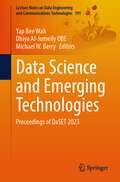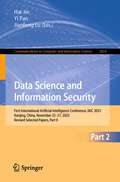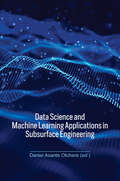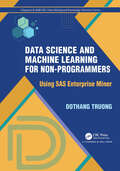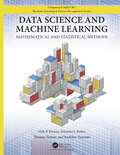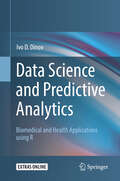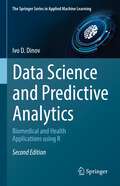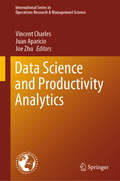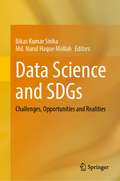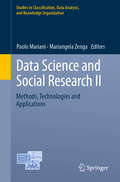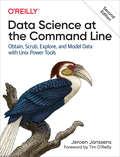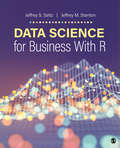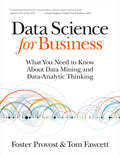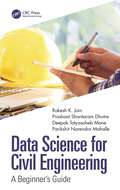- Table View
- List View
Data Science and Emerging Technologies: Proceedings of DaSET 2023 (Lecture Notes on Data Engineering and Communications Technologies #191)
by Michael W. Berry Yap Bee Wah Dhiya Al-Jumeily OBEThe book presents selected papers from International Conference on Data Science and Emerging Technologies (DaSET 2023), held online at UNITAR International University, Malaysia during December 4–5, 2023. This book presents current research and applications of data science and emerging technologies. The topics covered are artificial intelligence, big data technology, machine and deep learning, data mining, optimization algorithms, blockchain, Internet of Things (IoT), cloud computing, computer vision, cybersecurity, augmented and virtual reality, cryptography, and statistical learning.
Data Science and Information Security: First International Artificial Intelligence Conference, IAIC 2023, Nanjing, China, November 25–27, 2023, Revised Selected Papers, Part II (Communications in Computer and Information Science #2059)
by Yi Pan Hai Jin Jianfeng LuThis 3-volume set, CCIS 2058-2060 constitutes the First International Conference, on Artificial Intelligence, IAIC 2023, held in Nanjing, China, in November 2023. The 85 full papers presented were carefully reviewed and selected from 428 submissions. The papers are clustered in parts on: Artificial Intelligence and Machine Learning; Data Security and information Security; Computer Networks and IoT. The papers present recent research and developments in artificial intelligence and its applications in machine learning, natural language processing, computer vision, robotics, and ethical considerations.
Data Science and Machine Learning Applications in Subsurface Engineering
by Daniel Asante OtchereThis book covers unsupervised learning, supervised learning, clustering approaches, feature engineering, explainable AI and multioutput regression models for subsurface engineering problems. Processing voluminous and complex data sets are the primary focus of the field of machine learning (ML). ML aims to develop data-driven methods and computational algorithms that can learn to identify complex and non-linear patterns to understand and predict the relationships between variables by analysing extensive data. Although ML models provide the final output for predictions, several steps need to be performed to achieve accurate predictions. These steps, data pre-processing, feature selection, feature engineering and outlier removal, are all contained in this book. New models are also developed using existing ML architecture and learning theories to improve the performance of traditional ML models and handle small and big data without manual adjustments. This research-oriented book will help subsurface engineers, geophysicists, and geoscientists become familiar with data science and ML advances relevant to subsurface engineering. Additionally, it demonstrates the use of data-driven approaches for salt identification, seismic interpretation, estimating enhanced oil recovery factor, predicting pore fluid types, petrophysical property prediction, estimating pressure drop in pipelines, bubble point pressure prediction, enhancing drilling mud loss, smart well completion and synthetic well log predictions.
Data Science and Machine Learning for Non-Programmers: Using SAS Enterprise Miner (Chapman & Hall/CRC Data Mining and Knowledge Discovery Series)
by Dothang TruongAs data continues to grow exponentially, knowledge of data science and machine learning has become more crucial than ever. Machine learning has grown exponentially; however, the abundance of resources can be overwhelming, making it challenging for new learners. This book aims to address this disparity and cater to learners from various non-technical fields, enabling them to utilize machine learning effectively. Adopting a hands-on approach, readers are guided through practical implementations using real datasets and SAS Enterprise Miner, a user-friendly data mining software that requires no programming. Throughout the chapters, two large datasets are used consistently, allowing readers to practice all stages of the data mining process within a cohesive project framework. This book also provides specific guidelines and examples on presenting data mining results and reports, enhancing effective communication with stakeholders. Designed as a guiding companion for both beginners and experienced practitioners, this book targets a wide audience, including students, lecturers, researchers, and industry professionals from various backgrounds.
Data Science and Machine Learning: Mathematical and Statistical Methods (Chapman And Hall/crc Machine Learning And Pattern Recognition Ser.)
by Dirk P. Kroese Thomas Taimre Radislav Vaisman Zdravko Botev"This textbook is a well-rounded, rigorous, and informative work presenting the mathematics behind modern machine learning techniques. It hits all the right notes: the choice of topics is up-to-date and perfect for a course on data science for mathematics students at the advanced undergraduate or early graduate level. This book fills a sorely-needed gap in the existing literature by not sacrificing depth for breadth, presenting proofs of major theorems and subsequent derivations, as well as providing a copious amount of Python code. I only wish a book like this had been around when I first began my journey!" -Nicholas Hoell, University of Toronto "This is a well-written book that provides a deeper dive into data-scientific methods than many introductory texts. The writing is clear, and the text logically builds up regularization, classification, and decision trees. Compared to its probable competitors, it carves out a unique niche. -Adam Loy, Carleton College The purpose of Data Science and Machine Learning: Mathematical and Statistical Methods is to provide an accessible, yet comprehensive textbook intended for students interested in gaining a better understanding of the mathematics and statistics that underpin the rich variety of ideas and machine learning algorithms in data science. Key Features: Focuses on mathematical understanding. Presentation is self-contained, accessible, and comprehensive. Extensive list of exercises and worked-out examples. Many concrete algorithms with Python code. Full color throughout. Further Resources can be found on the authors website: https://github.com/DSML-book/Lectures
Data Science and Medical Informatics in Healthcare Technologies (SpringerBriefs in Applied Sciences and Technology)
by Nguyen Thi Dieu Linh Zhongyu (Joan) LuThis book highlights a timely and accurate insight at the endeavour of the bioinformatics and genomics clinicians from industry and academia to address the societal needs. The contents of the book unearth the lacuna between the medication and treatment in the current preventive medicinal and pharmaceutical system. It contains chapters prepared by experts in life sciences along with data scientists for examining the circumstances of health care system for the next decade. It also highlights the automated processes for analyzing data in clinical trial research, specifically for drug development. Additionally, the data science solutions provided in this book help pharmaceutical companies to improve on what had historically been manual, costly and laborious process for cross-referencing research in clinical trials on drug development, while laying the groundwork for use with a full range of other drugs for the conditions ranging from tuberculosis, to diabetes, to heart attacks and many others.
Data Science and Predictive Analytics: Biomedical And Health Applications Using R
by Ivo D. DinovOver the past decade, Big Data have become ubiquitous in all economic sectors, scientific disciplines, and human activities. They have led to striking technological advances, affecting all human experiences. Our ability to manage, understand, interrogate, and interpret such extremely large, multisource, heterogeneous, incomplete, multiscale, and incongruent data has not kept pace with the rapid increase of the volume, complexity and proliferation of the deluge of digital information. There are three reasons for this shortfall. First, the volume of data is increasing much faster than the corresponding rise of our computational processing power (Kryder’s law > Moore’s law). Second, traditional discipline-bounds inhibit expeditious progress. Third, our education and training activities have fallen behind the accelerated trend of scientific, information, and communication advances. There are very few rigorous instructional resources, interactive learning materials, and dynamic training environments that support active data science learning. The textbook balances the mathematical foundations with dexterous demonstrations and examples of data, tools, modules and workflows that serve as pillars for the urgently needed bridge to close that supply and demand predictive analytic skills gap. Exposing the enormous opportunities presented by the tsunami of Big data, this textbook aims to identify specific knowledge gaps, educational barriers, and workforce readiness deficiencies. Specifically, it focuses on the development of a transdisciplinary curriculum integrating modern computational methods, advanced data science techniques, innovative biomedical applications, and impactful health analytics. The content of this graduate-level textbook fills a substantial gap in integrating modern engineering concepts, computational algorithms, mathematical optimization, statistical computing and biomedical inference. Big data analytic techniques and predictive scientific methods demand broad transdisciplinary knowledge, appeal to an extremely wide spectrum of readers/learners, and provide incredible opportunities for engagement throughout the academy, industry, regulatory and funding agencies. The two examples below demonstrate the powerful need for scientific knowledge, computational abilities, interdisciplinary expertise, and modern technologies necessary to achieve desired outcomes (improving human health and optimizing future return on investment). This can only be achieved by appropriately trained teams of researchers who can develop robust decision support systems using modern techniques and effective end-to-end protocols, like the ones described in this textbook. • A geriatric neurologist is examining a patient complaining of gait imbalance and posture instability. To determine if the patient may suffer from Parkinson’s disease, the physician acquires clinical, cognitive, phenotypic, imaging, and genetics data (Big Data). Most clinics and healthcare centers are not equipped with skilled data analytic teams that can wrangle, harmonize and interpret such complex datasets. A learner that completes a course of study using this textbook will have the competency and ability to manage the data, generate a protocol for deriving biomarkers, and provide an actionable decision support system. The results of this protocol will help the physician understand the entire patient dataset and assist in making a holistic evidence-based, data-driven, clinical diagnosis.• To improve the return on investment for their shareholders, a healthcare manufacturer needs to forecast the demand for their product subject to environmental, demographic, economic, and bio-social sentiment data (Big Data). The organization’s data-analytics team is tasked with developing a protocol that identifies, aggregates, harmonizes, models and analyzes these heterogeneous data elements to generate a trend forecast. This system needs to provide an automated, adaptive, scalable, and reliable prediction of the optimal investment, e.g., R&D allocation, that maximizes the company’s bot
Data Science and Predictive Analytics: Biomedical and Health Applications using R (The Springer Series in Applied Machine Learning)
by Ivo D. DinovThis textbook integrates important mathematical foundations, efficient computational algorithms, applied statistical inference techniques, and cutting-edge machine learning approaches to address a wide range of crucial biomedical informatics, health analytics applications, and decision science challenges. Each concept in the book includes a rigorous symbolic formulation coupled with computational algorithms and complete end-to-end pipeline protocols implemented as functional R electronic markdown notebooks. These workflows support active learning and demonstrate comprehensive data manipulations, interactive visualizations, and sophisticated analytics. The content includes open problems, state-of-the-art scientific knowledge, ethical integration of heterogeneous scientific tools, and procedures for systematic validation and dissemination of reproducible research findings.Complementary to the enormous challenges related to handling, interrogating, and understanding massive amounts of complex structured and unstructured data, there are unique opportunities that come with access to a wealth of feature-rich, high-dimensional, and time-varying information. The topics covered in Data Science and Predictive Analytics address specific knowledge gaps, resolve educational barriers, and mitigate workforce information-readiness and data science deficiencies. Specifically, it provides a transdisciplinary curriculum integrating core mathematical principles, modern computational methods, advanced data science techniques, model-based machine learning, model-free artificial intelligence, and innovative biomedical applications. The book’s fourteen chapters start with an introduction and progressively build foundational skills from visualization to linear modeling, dimensionality reduction, supervised classification, black-box machine learning techniques, qualitative learning methods, unsupervised clustering, model performance assessment, feature selection strategies, longitudinal data analytics, optimization, neural networks, and deep learning. The second edition of the book includes additional learning-based strategies utilizing generative adversarial networks, transfer learning, and synthetic data generation, as well as eight complementary electronic appendices. This textbook is suitable for formal didactic instructor-guided course education, as well as for individual or team-supported self-learning. The material is presented at the upper-division and graduate-level college courses and covers applied and interdisciplinary mathematics, contemporary learning-based data science techniques, computational algorithm development, optimization theory, statistical computing, and biomedical sciences. The analytical techniques and predictive scientific methods described in the book may be useful to a wide range of readers, formal and informal learners, college instructors, researchers, and engineers throughout the academy, industry, government, regulatory, funding, and policy agencies. The supporting book website provides many examples, datasets, functional scripts, complete electronic notebooks, extensive appendices, and additional materials.
Data Science and Productivity Analytics (International Series in Operations Research & Management Science #290)
by Joe Zhu Juan Aparicio Vincent CharlesThis book includes a spectrum of concepts, such as performance, productivity, operations research, econometrics, and data science, for the practically and theoretically important areas of ‘productivity analysis/data envelopment analysis’ and ‘data science/big data’. Data science is defined as the collection of scientific methods, processes, and systems dedicated to extracting knowledge or insights from data and it develops on concepts from various domains, containing mathematics and statistical methods, operations research, machine learning, computer programming, pattern recognition, and data visualisation, among others. Examples of data science techniques include linear and logistic regressions, decision trees, Naïve Bayesian classifier, principal component analysis, neural networks, predictive modelling, deep learning, text analysis, survival analysis, and so on, all of which allow using the data to make more intelligent decisions. On the other hand, it is without a doubt that nowadays the amount of data is exponentially increasing, and analysing large data sets has become a key basis of competition and innovation, underpinning new waves of productivity growth. This book aims to bring a fresh look onto the various ways that data science techniques could unleash value and drive productivity from these mountains of data.Researchers working in productivity analysis/data envelopment analysis will benefit from learning about the tools available in data science/big data that can be used in their current research analyses and endeavours. The data scientists, on the other hand, will also get benefit from learning about the plethora of applications available in productivity analysis/data envelopment analysis.
Data Science and Risk Analytics in Finance and Insurance (Chapman and Hall/CRC Financial Mathematics Series)
by Tze Leung Lai Haipeng XingThis book presents statistics and data science methods for risk analytics in quantitative finance and insurance. Part I covers the background, financial models, and data analytical methods for market risk, credit risk, and operational risk in financial instruments, as well as models of risk premium and insolvency in insurance contracts. Part II provides an overview of machine learning (including supervised, unsupervised, and reinforcement learning), Monte Carlo simulation, and sequential analysis techniques for risk analytics. In Part III, the book offers a non-technical introduction to four key areas in financial technology: artificial intelligence, blockchain, cloud computing, and big data analytics.Key Features: Provides a comprehensive and in-depth overview of data science methods for financial and insurance risks. Unravels bandits, Markov decision processes, reinforcement learning, and their interconnections. Promotes sequential surveillance and predictive analytics for abrupt changes in risk factors. Introduces the ABCDs of FinTech: Artificial intelligence, blockchain, cloud computing, and big data analytics. Includes supplements and exercises to facilitate deeper comprehension.
Data Science and SDGs: Challenges, Opportunities and Realities
by Bikas Kumar Sinha Md. Nurul Haque MollahThe book presents contributions on statistical models and methods applied, for both data science and SDGs, in one place. Measuring and controlling data of SDGs, data driven measurement of progress needs to be distributed to stakeholders. In this situation, the techniques used in data science, specially, in the big data analytics, play an important role rather than the traditional data gathering and manipulation techniques. This book fills this space through its twenty contributions. The contributions have been selected from those presented during the 7th International Conference on Data Science and Sustainable Development Goals organized by the Department of Statistics, University of Rajshahi, Bangladesh; and cover topics mainly on SDGs, bioinformatics, public health, medical informatics, environmental statistics, data science and machine learning. The contents of the volume would be useful to policymakers, researchers, government entities, civil society, and nonprofit organizations for monitoring and accelerating the progress of SDGs.
Data Science and Social Research II: Methods, Technologies and Applications (Studies in Classification, Data Analysis, and Knowledge Organization)
by Paolo Mariani Mariangela ZengaThe peer-reviewed contributions gathered in this book address methods, software and applications of statistics and data science in the social sciences. The data revolution in social science research has not only produced new business models, but has also provided policymakers with better decision-making support tools. In this volume, statisticians, computer scientists and experts on social research discuss the opportunities and challenges of the social data revolution in order to pave the way for addressing new research problems. The respective contributions focus on complex social systems and current methodological advances in extracting social knowledge from large data sets, as well as modern social research on human behavior and society using large data sets. Moreover, they analyze integrated systems designed to take advantage of new social data sources, and discuss quality-related issues. The papers were originally presented at the 2nd International Conference on Data Science and Social Research, held in Milan, Italy, on February 4-5, 2019.
Data Science at the Command Line: Obtain, Scrub, Explore, and Model Data with Unix Power Tools
by Jeroen JanssensThis thoroughly revised guide demonstrates how the flexibility of the command line can help you become a more efficient and productive data scientist. You'll learn how to combine small yet powerful command-line tools to quickly obtain, scrub, explore, and model your data. To get you started, author Jeroen Janssens provides a Docker image packed with over 100 Unix power tools--useful whether you work with Windows, macOS, or Linux.You'll quickly discover why the command line is an agile, scalable, and extensible technology. Even if you're comfortable processing data with Python or R, you'll learn how to greatly improve your data science workflow by leveraging the command line's power. This book is ideal for data scientists, analysts, engineers, system administrators, and researchers.Obtain data from websites, APIs, databases, and spreadsheetsPerform scrub operations on text, CSV, HTML, XML, and JSON filesExplore data, compute descriptive statistics, and create visualizationsManage your data science workflowCreate your own tools from one-liners and existing Python or R codeParallelize and distribute data-intensive pipelinesModel data with dimensionality reduction, regression, and classification algorithmsLeverage the command line from Python, Jupyter, R, RStudio, and Apache Spark
Data Science for Business With R
by Jeffrey S. Saltz Jeffrey Morgan StantonData Science for Business with R, written by Jeffrey S. Saltz and Jeffrey M. Stanton, focuses on the concepts foundational for students starting a business analytics or data science degree program. To keep the book practical and applied, the authors feature a running case using a global airline business’s customer survey dataset to illustrate how to turn data in business decisions, in addition to numerous examples throughout. To aid in usability beyond the classroom, the text features full integration of freely-available R and RStudio software, one of the most popular data science tools available. Designed for students with little to no experience in related areas like computer science, the book chapters follow a logical order from introduction and installation of R and RStudio, working with data architecture, undertaking data collection, performing data analysis, and transitioning to data archiving and presentation. Each chapter follows a familiar structure, starting with learning objectives and background, following the basic steps of functions alongside simple examples, applying these functions to the case study, and ending with chapter challenge questions, sources, and a list of R functions so students know what to expect in each step of their data science course. Data Science for Business with R provides readers with a straightforward and applied guide to this new and evolving field.
Data Science for Business With R
by Jeffrey S. Saltz Jeffrey Morgan StantonData Science for Business with R, written by Jeffrey S. Saltz and Jeffrey M. Stanton, focuses on the concepts foundational for students starting a business analytics or data science degree program. To keep the book practical and applied, the authors feature a running case using a global airline business’s customer survey dataset to illustrate how to turn data in business decisions, in addition to numerous examples throughout. To aid in usability beyond the classroom, the text features full integration of freely-available R and RStudio software, one of the most popular data science tools available. Designed for students with little to no experience in related areas like computer science, the book chapters follow a logical order from introduction and installation of R and RStudio, working with data architecture, undertaking data collection, performing data analysis, and transitioning to data archiving and presentation. Each chapter follows a familiar structure, starting with learning objectives and background, following the basic steps of functions alongside simple examples, applying these functions to the case study, and ending with chapter challenge questions, sources, and a list of R functions so students know what to expect in each step of their data science course. Data Science for Business with R provides readers with a straightforward and applied guide to this new and evolving field.
Data Science for Business: What You Need to Know about Data Mining and Data-Analytic Thinking
by Tom Fawcett Foster ProvostWritten by renowned data science experts Foster Provost and Tom Fawcett, Data Science for Business introduces the fundamental principles of data science, and walks you through the "data-analytic thinking" necessary for extracting useful knowledge and business value from the data you collect. This guide also helps you understand the many data-mining techniques in use today.Based on an MBA course Provost has taught at New York University over the past ten years, Data Science for Business provides examples of real-world business problems to illustrate these principles. You’ll not only learn how to improve communication between business stakeholders and data scientists, but also how participate intelligently in your company’s data science projects. You’ll also discover how to think data-analytically, and fully appreciate how data science methods can support business decision-making.Understand how data science fits in your organization—and how you can use it for competitive advantageTreat data as a business asset that requires careful investment if you’re to gain real valueApproach business problems data-analytically, using the data-mining process to gather good data in the most appropriate wayLearn general concepts for actually extracting knowledge from dataApply data science principles when interviewing data science job candidates
Data Science for Civil Engineering: A Beginner's Guide
by Prashant Shantaram Dhotre Parikshit Narendra Mahalle Rakesh K. Jain Deepak Tatyasaheb ManeThis book explains use of data science-based techniques for modeling and providing optimal solutions to complex problems in civil engineering. It discusses civil engineering problems like air, water and land pollution, climate crisis, transportation infrastructures, traffic and travel modes, mobility services, and so forth. Divided into two sections, the first one deals with the basics of data science and essential mathematics while the second section covers pertinent applications in structural and environmental engineering, construction management, and transportation. Features: Details information on essential mathematics required to implement civil engineering applications using data science techniques. Discusses broad background of data science and its fundamentals. Focusses on structural engineering, transportation systems, water resource management, geomatics, and environmental engineering. Includes python programming libraries to solve complex problems. Addresses various real-world applications of data science based civil engineering use cases. This book aims at senior undergraduate students in Civil Engineering and Applied Data Science.
Data Science for Infectious Disease Data Analytics: An Introduction with R (Chapman & Hall/CRC Data Science Series)
by Lily WangData Science for Infectious Disease Data Analytics: An Introduction with R provides an overview of modern data science tools and methods that have been developed specifically to analyze infectious disease data. With a quick start guide to epidemiological data visualization and analysis in R, this book spans the gulf between academia and practices providing many lively, instructive data analysis examples using the most up-to-date data, such as the newly discovered coronavirus disease (COVID-19). The primary emphasis of this book is the data science procedures in epidemiological studies, including data wrangling, visualization, interpretation, predictive modeling, and inference, which is of immense importance due to increasingly diverse and nonexperimental data across a wide range of fields. The knowledge and skills readers gain from this book are also transferable to other areas, such as public health, business analytics, environmental studies, or spatio-temporal data visualization and analysis in general. Aimed at readers with an undergraduate knowledge of mathematics and statistics, this book is an ideal introduction to the development and implementation of data science in epidemiology. Features Describes the entire data science procedure of how the infectious disease data are collected, curated, visualized, and fed to predictive models, which facilitates effective communication between data sources, scientists, and decision-makers. Explains practical concepts of infectious disease data and provides particular data science perspectives. Overview of the unique features and issues of infectious disease data and how they impact epidemic modeling and projection. Introduces various classes of models and state-of-the-art learning methods to analyze infectious diseases data with valuable insights on how different models and methods could be connected.
Data Science for Mathematicians (CRC Press/Chapman and Hall Handbooks in Mathematics Series)
by Nathan CarterMathematicians have skills that, if deepened in the right ways, would enable them to use data to answer questions important to them and others, and report those answers in compelling ways. Data science combines parts of mathematics, statistics, computer science. Gaining such power and the ability to teach has reinvigorated the careers of mathematicians. This handbook will assist mathematicians to better understand the opportunities presented by data science. As it applies to the curriculum, research, and career opportunities, data science is a fast-growing field. Contributors from both academics and industry present their views on these opportunities and how to advantage them.
Data Science for Public Policy (Springer Series in the Data Sciences)
by Jeffrey C. Chen Edward A. Rubin Gary J. CornwallThis textbook presents the essential tools and core concepts of data science to public officials, policy analysts, and economists among others in order to further their application in the public sector. An expansion of the quantitative economics frameworks presented in policy and business schools, this book emphasizes the process of asking relevant questions to inform public policy. Its techniques and approaches emphasize data-driven practices, beginning with the basic programming paradigms that occupy the majority of an analyst’s time and advancing to the practical applications of statistical learning and machine learning. The text considers two divergent, competing perspectives to support its applications, incorporating techniques from both causal inference and prediction. Additionally, the book includes open-sourced data as well as live code, written in R and presented in notebook form, which readers can use and modify to practice working with data.
Data Science for Sensory and Consumer Scientists (Chapman & Hall/CRC Data Science Series)
by John Ennis Thierry Worch Julien Delarue Vanessa Rios De SouzaData Science for Sensory and Consumer Scientists is a comprehensive textbook that provides a practical guide to using data science in the field of sensory and consumer science through real-world applications. It covers key topics including data manipulation, preparation, visualization, and analysis, as well as automated reporting, machine learning, text analysis, and dashboard creation. Written by leading experts in the field, this book is an essential resource for anyone looking to master the tools and techniques of data science and apply them to the study of consumer behavior and sensory-led product development. Whether you are a seasoned professional or a student just starting out, this book is the ideal guide to using data science to drive insights and inform decision-making in the sensory and consumer sciences. Key Features: • Elucidation of data scientific workflow. • Introduction to reproducible research. • In-depth coverage of data-scientific topics germane to sensory and consumer science. • Examples based in industrial practice used throughout the book
Data Science for Transport: A Self-study Guide With Computer Exercises (Springer Textbooks In Earth Sciences, Geography And Environment Ser.)
by Charles FoxThe quantity, diversity and availability of transport data is increasing rapidly, requiring new skills in the management and interrogation of data and databases. Recent years have seen a new wave of 'big data', 'Data Science', and 'smart cities' changing the world, with the Harvard Business Review describing Data Science as the "sexiest job of the 21st century". Transportation professionals and researchers need to be able to use data and databases in order to establish quantitative, empirical facts, and to validate and challenge their mathematical models, whose axioms have traditionally often been assumed rather than rigorously tested against data. This book takes a highly practical approach to learning about Data Science tools and their application to investigating transport issues. The focus is principally on practical, professional work with real data and tools, including business and ethical issues."Transport modeling practice was developed in a data poor world, and many of our current techniques and skills are building on that sparsity. In a new data rich world, the required tools are different and the ethical questions around data and privacy are definitely different. I am not sure whether current professionals have these skills; and I am certainly not convinced that our current transport modeling tools will survive in a data rich environment. This is an exciting time to be a data scientist in the transport field. We are trying to get to grips with the opportunities that big data sources offer; but at the same time such data skills need to be fused with an understanding of transport, and of transport modeling. Those with these combined skills can be instrumental at providing better, faster, cheaper data for transport decision- making; and ultimately contribute to innovative, efficient, data driven modeling techniques of the future. It is not surprising that this course, this book, has been authored by the Institute for Transport Studies. To do this well, you need a blend of academic rigor and practical pragmatism. There are few educational or research establishments better equipped to do that than ITS Leeds". - Tom van Vuren, Divisional Director, Mott MacDonald"WSP is proud to be a thought leader in the world of transport modelling, planning and economics, and has a wide range of opportunities for people with skills in these areas. The evidence base and forecasts we deliver to effectively implement strategies and schemes are ever more data and technology focused a trend we have helped shape since the 1970's, but with particular disruption and opportunity in recent years. As a result of these trends, and to suitably skill the next generation of transport modellers, we asked the world-leading Institute for Transport Studies, to boost skills in these areas, and they have responded with a new MSc programme which you too can now study via this book." - Leighton Cardwell, Technical Director, WSP."From processing and analysing large datasets, to automation of modelling tasks sometimes requiring different software packages to "talk" to each other, to data visualization, SYSTRA employs a range of techniques and tools to provide our clients with deeper insights and effective solutions. This book does an excellent job in giving you the skills to manage, interrogate and analyse databases, and develop powerful presentations. Another important publication from ITS Leeds." - Fitsum Teklu, Associate Director (Modelling & Appraisal) SYSTRA Ltd"Urban planning has relied for decades on statistical and computational practices that have little to do with mainstream data science. Information is still often used as evidence on the impact of new infrastructure even when it hardly contains any valid evidence. This book is an extremely welcome effort to provide young professionals with the skills needed to analyse how cities and transport networks actually work. The book is also highly relevant to anyone who will later want to build digital solutions to optimise urban travel based on emerging data sources". - Yaron Hollander, author of "T
Data Science from Scratch: First Principles with Python
by Joel GrusData science libraries, frameworks, modules, and toolkits are great for doing data science, but they’re also a good way to dive into the discipline without actually understanding data science. With this updated second edition, you’ll learn how many of the most fundamental data science tools and algorithms work by implementing them from scratch.If you have an aptitude for mathematics and some programming skills, author Joel Grus will help you get comfortable with the math and statistics at the core of data science, and with hacking skills you need to get started as a data scientist. Today’s messy glut of data holds answers to questions no one’s even thought to ask. This book provides you with the know-how to dig those answers out.
Data Science für Dummies (Für Dummies)
by Lillian PiersonDaten, Daten, Daten? Sie haben schon Kenntnisse in Excel und Statistik, wissen aber noch nicht, wie all die Datensätze helfen sollen, bessere Entscheidungen zu treffen? Von Lillian Pierson bekommen Sie das dafür notwendige Handwerkszeug: Bauen Sie Ihre Kenntnisse in Statistik, Programmierung und Visualisierung aus. Nutzen Sie Python, R, SQL, Excel und KNIME. Zahlreiche Beispiele veranschaulichen die vorgestellten Methoden und Techniken. So können Sie die Erkenntnisse dieses Buches auf Ihre Daten übertragen und aus deren Analyse unmittelbare Schlüsse und Konsequenzen ziehen.
Data Science in Agriculture and Natural Resource Management (Studies in Big Data #96)
by Sanjay Chaudhary G. P. Obi Reddy Mehul S. Raval J. AdinarayanaThis book aims to address emerging challenges in the field of agriculture and natural resource management using the principles and applications of data science (DS). The book is organized in three sections, and it has fourteen chapters dealing with specialized areas. The chapters are written by experts sharing their experiences very lucidly through case studies, suitable illustrations and tables. The contents have been designed to fulfil the needs of geospatial, data science, agricultural, natural resources and environmental sciences of traditional universities, agricultural universities, technological universities, research institutes and academic colleges worldwide. It will help the planners, policymakers and extension scientists in planning and sustainable management of agriculture and natural resources. The authors believe that with its uniqueness the book is one of the important efforts in the contemporary cyber-physical systems.
